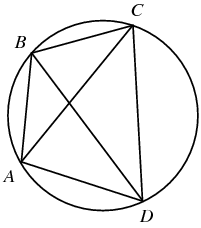
For a
cyclic quadrilateral, the sum
of the products of the two pairs of opposite sides equals the product of the
diagonals
(Kimberling 1998, p. 223).
Cyclic Quadrilateral
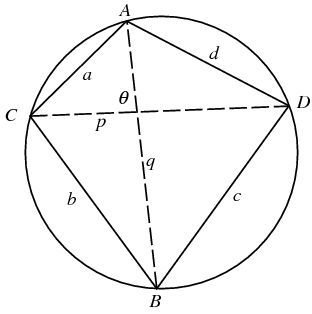
A cyclic quadrilateral is a
quadrilateral
for which a
circle can be circumscribed so that it
touches each
polygon vertex. A quadrilateral
that can be both inscribed and circumscribed on some pair of circles is known as
a
bicentric quadrilateral.
The
area of a cyclic quadrilateral is the
maximum possible for any
quadrilateral with the given side lengths. The
opposite
angles of a cyclic quadrilateral sum to
 radians
radians (Euclid, Book III, Proposition 22; Heath 1956;
Dunham 1990, p. 121). There exists a closed
billiards path inside a cyclic quadrilateral if its
circumcenter lies inside the quadrilateral
(Wells 1991, p. 11).
The
area is then given by a special case of
Bretschneider's formula. Let the sides
have lengths

,

,

, and

, let

be
the
semiperimeter
 |
(1)
|
and let

be
the
circumradius. Then
the first of which is known as
Brahmagupta's formula. Solving for the
circumradius in (
2) and (
3) gives
 |
(4)
|
The
diagonals of a cyclic quadrilateral
have lengths
so that

.
In general, there are three essentially distinct cyclic quadrilaterals
(modulo
rotation and
reflection) whose edges are permutations of the
lengths

,

,

, and

. Of
the six corresponding
polygon diagonals
lengths, three are distinct. In addition to

and

,
there is therefore a "third"
polygon
diagonal which can be denoted

. It
is given by the equation
 |
(7)
|
This allows the
area formula to be written in the
particularly beautiful and simple form
 |
(8)
|
The
polygon diagonals are sometimes also
denoted

,

, and

.
The
incenters of the four triangles composing
the cyclic quadrilateral form a
rectangle.
Furthermore, the sides of the
rectangle are
parallel to the lines connecting the
mid-arc points between each pair of vertices
(left figure above; Fuhrmann 1890, p. 50; Johnson 1929, pp. 254-255; Wells
1991). If the
excenters of the triangles
constituting the quadrilateral are added to the
incenters, a

rectangular grid is obtained (right figure; Johnson 1929, p. 255; Wells 1991).
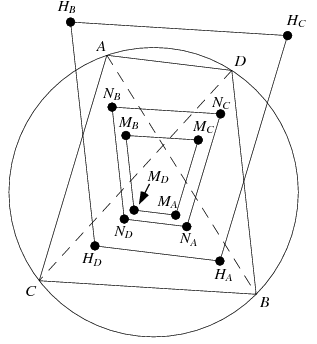
Consider again the four triangles contained in a cyclic quadrilateral.
Amazingly, the
triangle centroids 
,
nine-point centers 
, and
orthocenters 
formed by these triangles are similar to the original quadrilateral. In fact,
the triangle formed by the
orthocenters is
congruent to it (Wells 1991, p. 44).
A cyclic quadrilateral with
rational sides

,

,

, and

,
polygon diagonals 
and

,
circumradius 
, and
area 
is given by

,

,

,

,

,

,

,
and

.
Let

be
a
quadrilateral such that the angles

and

are
right angles, then

is a cyclic quadrilateral (Dunham 1990). This is a
corollary of the theorem that, in a
right triangle, the
midpoint of the
hypotenuse is equidistant from the three
vertices. Since

is
the
midpoint of both
right triangles 
and

, it
is equidistant from all four
vertices, so a
circle centered at

may be drawn through them. This theorem is one of the building blocks
of Heron's derivation of
Heron's formula.
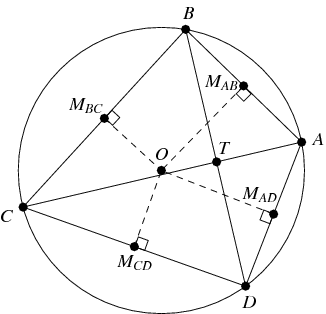
An application of
Brahmagupta's
theorem gives the pretty result that, for a cyclic quadrilateral with
perpendicular diagonals, the distance from the
circumcenter 
to a side is half the length of the opposite side, so in the above
figure,
 |
(9)
|
and so on (Honsberger 1995, pp. 37-38).
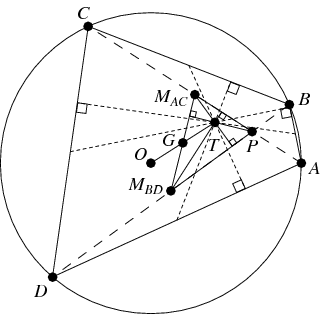
Let

and

be
the
midpoints of the diagonals of a cyclic
quadrilateral

,
and let

be
the intersection of the diagonals. Then the
orthocenter of
triangle 
is the
anticenter 
of

(Honsberger 1995, p. 39).
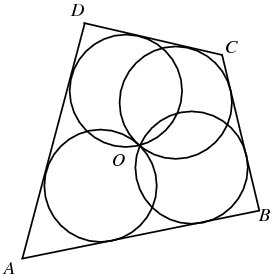
Place four equal
circles so that they
intersect in a point. The quadrilateral

is
then a cyclic quadrilateral (Honsberger 1991). For a
convex cyclic quadrilateral

, consider the set of
convex cyclic
quadrilaterals

whose sides are
parallel to

.
Then the

of
maximal
area is the one whose
polygon diagonals are
perpendicular (Gürel 1996).
Wolfram


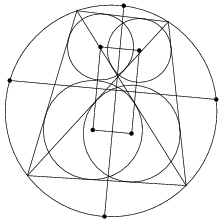
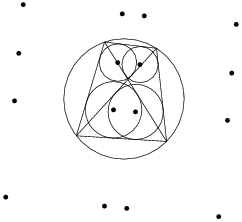




댓글 없음:
댓글 쓰기